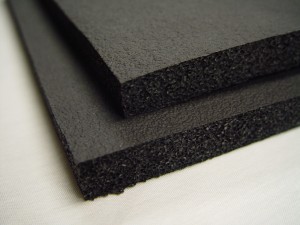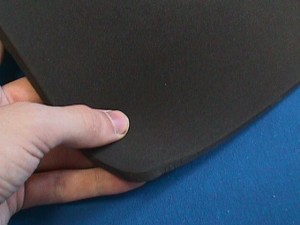Foam rubbers are durable materials made of varying blends of polymers and elastomers that produce some of the most versatile and unique materials in the world of foam. With their substantial list of applications and characteristics, neoprene sheets and gymnastic rubber are two of the most useful and utilitarian products in Foam Factory, Inc.’s catalog, and can easily be customized to fit any application for which their attributes provide the best solution.

A medium-weight, resistant material, neoprene is a foam rubber available in multiple variations. The three major types include chloroprene rubber (CR), styrene-butadiene rubber (SBR) and ethylene-propylene-diene-monomer (EPDM). These varying blends create slight variations in the material, with each having their own set of performance characteristics and best applications.
The simplest and “purest” form because of its lack of blending is the CR foam rubber, the oldest of the three. This material is durable, but not to the degree of some of the blended forms which have undergone formulaic additions to enhance performance attributes. Still, this material performs well as seals, bearings and in gasket applications because of its resistance to water and many oils and fluids. SBR is a blending of the monomers styrene and butadiene, developed during World War II to compete with natural rubber and compensate for its supply shortage. The advantages over natural rubber include better water, organism, and abrasion resistance, as well as better flex and tear resistance and tensile strength.
Foam Factory carries the blended EPDM rubber as their neoprene product. This formulation of monomers allows excellent moisture and temperature resistance which makes it useful in gasket and insulation applications. It is very resistant to weather, sunlight, chemicals, oxidation and petroleum derivatives like similar formulations, but it also includes Ozone resistance, a quality not all other materials possess. A very consistent foam rubber, this closed-cell foam is cut into sheets as thin as 1/8″, or as thick as 2″, and is available in regular and high quality. These rubber sheets have even been used to line roofs and aid in the collection of rainwater, as it is a non-toxic material. EPDM also holds an advantage in cost over CR neoprene rubber by using more affordable materials in its blend.

Gymnastic rubber is another widely recognized high density foam rubber product. These durable sections of black foam are frequently seen as matting or padding in school gymnasium flooring or as a fitness flooring in health clubs. Gym rubber products are based similarly to the neoprene types, with a butadiene rubber formula, but including nitriles as well (NBR). The materials Foam Factory stocks are polyvinyl-chloride nitrile-butadiene-rubber, or PVC/NBR. These dense, flexible forms of foam rubber have many applications beyond their athletic flooring uses. Gym rubber is frequently used as kneeling and camping mats because it is able function as a foam cushion for hard surfaces while still providing enough stability and strength to keep users from bottoming out to the ground. Its insulation values keep people warm on the ground as sleeping pads, as well as allowing it to be used for building insulation because of the relatively small space it takes up for the amount of insulating performance it provides. This product is cut most typically in sheet form but can be modified to contain interlocking edges for temporary or traveling mat setups.
Foam rubbers provide a range of services that go from money-saving and practical like insulation, to recreational and interactive like exercise mats. The variances in formula allow many different products to share core traits while tailoring them to special jobs at the same time. The benefits of foam rubbers can be applied to all of their applications, with their specialization making each one stand out as an individually useful material.


Do you offer a NPVC Foam Tube having a 3/4″ I.D. with a 1″ wall thickness.
I am sorry, the closest we have available is our black gym rubber.
What type of foam is commonly used for toolbox liners?
For this application, we would suggest either our 2.2lb Polyethylenefoam, or, if you want something that can be color coded, our 2lb Crosslinked Polyethylenefoam.
Is neoprene foam not suitable as an insole because it’s waterproof/not breathable or is there a use case for it? What foam would be better to use as a shoe insert (insole)?
Neoprenecan be used for this application. Another foam that is sometimes used is our Minicel T200foam.
For use in a car as a carpet under cushion is neoprene rubber or gym rubber suitable?
Gym rubber is suggested.